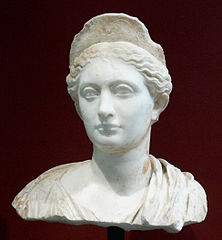The Romans also had their gods and goddesses, though some of these were devised from the Greek gods and goddesses.
- Jupiter - King of Gods
- Juno - Queen of Gods
- Neptune - God of sea
- Pluto - God of death
- Apollo - God of sun
- Diana - Godess of moon
- Mars - God of war
- Venus - Goddess of love
- Cupid - God of love
- Mercury - Messenger of Gods
- Minerva - Goddess of wisdom
- Ceres - Earth Goddess
- Proserpine - Goddess of underworld
- Vulcan - The smith God
- Bacchus - God of wine
- Saturn - God of time
- Vesta - Goddess of the home
- Janus - God of doors
- Uranus and Gaia - Parents of Saturn
- Maia - Goddess of growth
- Flora - Goddess of flowers
- Plutus - God of wealth
Roman Art
The ancient Romans admires the Greek art, so after conquering Greece, the Romans took the Greek artists to Rome to work for them. These sculptures included many different forms such as full body statues, busts (head and shoulders), reliefs (sculptures that are part of a wall) and sarcophagi sculptures on tombs. Sculpture were very popular with the rich Romans as they believed that if a bust of a dead relative was poor in likeness, that relative would come back to haunt the family. This meant that the sculpting techniques developed quickly to make sure that the likenesses were true. Some sculptures also became narrative with stories of the battles of the gods. Some artists mass produced bodies without the heads, so that when a order came in they would only have to sculpt the head, thus saving time and giving them the option to make many sculptures in little time. They also sometimes did this with the hands on the bodies, as some customers may want them to be portrayed as thinkers (with a scroll) or a mighty fighter (with a sword).Roman coins was another method of art in the portrait sense. The coins often had faces on them in profile, most commonly god such as Venus, Mars or Jupiter and also iconic rulers such as Caligula, Augustus and the Caesars. One of the earliest Roman coins that have been found has god Jupiter and hero Hercules molded into it. Roman emperors had inscriptions and their busts engraved into their coins, which served as early propaganda. The inscriptions told of the emperors traits which would be 'scripted' to show the emperors as great and successful leaders. Just like present day, frauds would make coins themselves, to battle this the Romans would also have mint marks on the coins so that the city and workshop that the coin was made in can be identified.
 |
| Roman bust sculpture |
GLADIATORS...ARE YOU READY?!
The gladiator fights are one of the things the Romans are best remembered for. The Colosseum was the arena for these fights and the gladiators could end up fighting people or animals, this also included women! The gladiator fights originally was a funeral right. A wealthy person would pay for a fight at their funeral, and the losing gladiator would serve as a sort of sacrifice. These fights were then brought to the Colosseum and became more public entertainment than sacrifices. The gladiators were most commonly criminals, slave or prisoners of war, however some were just a method to pay off a debt to someone. A gladiator who fought well could become famous, history's first celebrities, or wealthy or, f they were originally a slave, gain their freedom. During their long and painful training, the gladiators are taught to fight to the death, which the symbolic thumbs giving them life or death is seen throughout many medias. If a gladiator was dying on the arena floor, a man dressed as the god Charon would use a large hammer to smash on their heads, so that they could not fake death. The gladiator types were:
- Mymillo - dagger and shield
- Thracian - small shield and curved dagger
- Andabatus - blind gladiator
- Essedarius - chariot gladiator
- Retarius - net and triton
- Sammite - visored helment with feathers
- Dimachaerius - dual dagger, but little amour
- Laquerius - similar to Retarius, but with a lasso
- Secutor - chases opponent
- Velitus - only has a spear
- http://en.wikipedia.org/wiki/Ancient_Rome
- http://wps.ablongman.com/wps/media/objects/262/268312/art/figures/KISH106.jpg
- http://www.ducksters.com/history/art/ancient_roman_art.php
- http://www.ehow.co.uk/info_7969668_information-roman-coins-kids.html
- http://rome.mrdonn.org/gladiators.html
- http://www.salariya.com/web_books/gladiator/whos_who/pages/whos_who.html
- http://www.youtube.com/watch?v=yLVnFEXnHB8&feature=relmfu
- http://www.youtube.com/watch?v=D5FU0ZMRB_Q
- http://www.youtube.com/watch?v=ExWfh6sGyso
No comments:
Post a Comment